Fish
How to Name Your Red Fish
Pondering how to name your red fish? Dive into this guide for vibrant and meaningful name ideas that will bring your fish to life!

When choosing a name for your red fish, think about bold colors like Ruby or Scarlet to add intensity. Drawing inspiration from meaningful places, events, or qualities can help establish emotional connections. Consider names inspired by elements of fire, such as Ember or Blaze, for added vibrancy. Characters from media, like Ariel, can provide charm. Unique names inspired by locations can add depth to your fish’s identity. Nature-inspired names like Coralie can evoke natural beauty. Don’t be afraid to explore names from other languages, such as Rubino, for a unique touch. Suggestions like Blaze or Rosalie can add personality to your fish’s name. To find the perfect name, combine color, meaning, and personal significance. Use your creativity to give your red fish a special identity that is full of character and meaning.
Key Takeaways
- Consider vibrant color and intensity when naming your red fish.
- Reflect on significant places, events, or qualities for emotional connections.
- Choose fire-inspired names like Ember or Blaze for intensity.
- Draw inspiration from media characters for a special connection.
- Opt for nature-inspired or meaningful names like Rouge or Phoenix.
Consider Your Fishs Color
When choosing a name for your red fish, consider its vibrant color as a key factor. The rich red hue of your fish presents an opportunity to give it a name that truly reflects its striking appearance.
Names like Ruby or Garnet can emphasize the vividness of its color, while options like Scarlet or Crimson can highlight the intensity of its red tones. Choosing a name that complements the deep red shades of your fish, such as Merlot or Burgundy, can add an extra layer of significance to your pet's identity.
For those looking to connect the name of their red fish with its color on a more personal level, names like Sangria or Port can evoke a sense of richness and depth. Ultimately, selecting a name that resonates with the vibrant redness of your fish can create a meaningful and fitting choice that enhances your bond with your aquatic companion.
Reflect on Personal Significance

Reflecting on the personal significance of your red fish can lead to a deeper connection and a more meaningful naming process. When considering the personal significance of your red fish, there are a few key aspects to ponder:
- Naming your red fish after a significant place, event, or memory in your life can create a strong emotional bond.
- Reflecting on unique characteristics or behaviors of your red fish can help you choose a name that truly represents its personality.
- Incorporating elements of your red fish's habitat or environment into its name adds a special touch and connection to its natural surroundings.
- Selecting a name that symbolizes qualities like strength, resilience, or other characteristics you admire in your red fish can reinforce the bond you share.
Fire-Inspired Names
Exploring fire-inspired names for your red fish can add a touch of intensity and vibrancy to its identity. Fire-inspired names like Ember, Blaze, Flame, Inferno, or Phoenix can be particularly fitting for a red fish, reflecting both its vibrant color and fiery personality. These names evoke feelings of warmth, energy, and intensity that complement the striking red hue of the fish. By selecting a fire-inspired name, you can introduce a unique and dynamic element to your red fish's character, making it stand out even more.
It's important to investigate the symbolism and meanings associated with fire when choosing a name for your red fish. Fire represents passion, transformation, and power, all of which can resonate with the lively nature of a red fish. So, when deciding on a fire-inspired name for your aquatic companion, consider the emotions and imagery that the name evokes, ensuring it encapsulates the fiery spirit of your red fish.
Movie or Book Characters
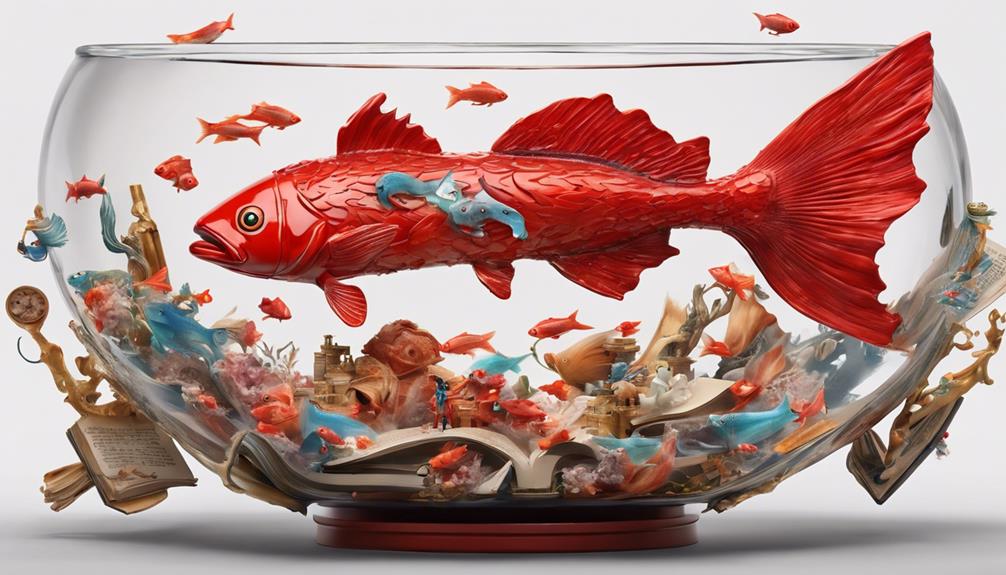
When considering names for your red fish, looking to iconic movie or book characters can be a great source of inspiration. Characters like Ariel from 'The Little Mermaid' or Scarlet Witch from Marvel comics offer unique and memorable options.
Drawing from these fictional favorites can help you find a name that resonates with your fish's personality and creates a special connection.
Iconic Character Names
Which iconic character names from movies or books could inspire a unique and memorable name for your red fish? Consider characters like Ariel, Nemo, Dory, Ursula, or Poseidon for a fun and whimsical touch to your fish's identity.
Drawing inspiration from beloved characters can create a special bond between you and your fish, enhancing the overall experience of caring for them. When selecting a name, think about the personality traits or characteristics associated with the character, and how they align with your red fish.
Fictional Favorites for Fish
Drawing inspiration from iconic characters in movies or books can lead to creative and memorable names for your red fish. Characters like Nemo from 'Finding Nemo' or Flounder from 'The Little Mermaid' offer charming options for naming your aquatic companion. These fictional favorites can infuse personality and charm into your fish's identity, making the naming process enjoyable and meaningful.
Whether you prefer a friendly name like Nemo or a more adventurous moniker like Bruce from 'Finding Nemo,' there are endless possibilities to explore. By choosing a name from beloved movies or books, you not only add a touch of whimsy to your red fish's persona but also create a connection to iconic characters that hold a special place in popular culture.
Finding Inspiration From Media
Gaining inspiration from popular media characters can lead to unique and memorable names for your red fish. Here are some tips on finding the perfect name inspired by movie or book characters:
- Explore Popular Names: Characters like Nemo, Dory, Luca, or Sabrina can offer fun and recognizable choices for your fish.
- Add a Funny Twist: Consider humorous names like Ursula or Sabrina to inject some laughter into your fish's identity.
- Powerful and Mythical: Draw from iconic figures like Poseidon or Triton for a majestic and mythical name for your aquatic companion.
- Reflect Nature: Nature-themed names such as Caspian, Marlin, or River can capture the essence and beauty of your red fish's underwater world.
Finding inspiration from media characters can make the naming process entertaining and meaningful.
Special Place Names

When naming your red fish after a special place, consider unique location-inspired names that hold personal significance, like a treasured vacation spot or a meaningful destination.
Opt for nature-inspired place names that resonate with the vibrant red color of your fish, creating a connection between the name and its appearance.
Reflect on the characteristics of the place you choose, drawing inspiration from its history, culture, or natural beauty to infuse a sense of adventure and personal connection into your fish's identity.
Unique Location-Inspired Names
Considering our personal connections to special places, naming your red fish after a unique location can add a touch of nostalgia and meaning to its identity. Here are some reasons to choose a location-inspired name for your red fish:
- Personal Connection: A name tied to a special place can evoke cherished memories.
- Geographical Significance: It adds a layer of depth and meaning to your fish's identity.
- Conversation Starter: It can spark interesting conversations about the location behind the name.
- Emotional Attachment: Naming your fish after a place you love creates a bond between you and your aquatic companion.
Personal Meaningful Locations
Naming your red fish after a personal meaningful location can infuse its identity with sentimental value and create a unique bond between you and your aquatic companion. Choosing a name that resonates with special memories can deepen the connection you share with your fish, making the naming process more intimate and significant. Below is a table showcasing examples of names inspired by personal locations that could be perfect for your fish:
| Fish Names | Special Place |
|---|---|
| Coral | Great Barrier Reef |
| Aspen | Rocky Mountains |
| Savannah | African Plains |
| Rio | Brazilian River |
| Maui | Hawaiian Island |
Nature-Inspired Place Names
Let's explore how incorporating nature-inspired place names can enhance the unique identity of your red fish.
- Nature-inspired place names like Coralie, Marlin, or River can reflect the aquatic environment where red fish thrive, adding depth to their persona.
- These special names evoke connections to natural habitats such as the Caspian Sea or a serene river setting, enriching the essence of your red fish.
- Choosing a name like Reed can bring tranquility and harmony inspired by nature into your red fish's world.
- Place names such as Coralie highlight the vibrant and colorful nature of red fish, embracing the beauty of their underwater domain.
Meaningful Words in Other Languages
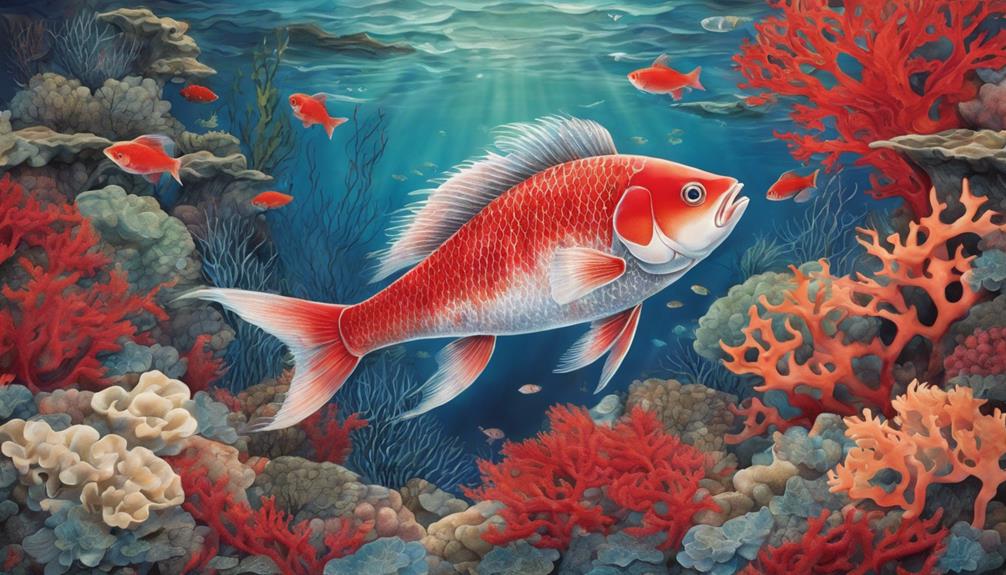
Exploring meaningful words in different languages can enrich the process of naming your red fish, adding cultural depth and uniqueness to the choice. When considering an Italian name, 'rubino' stands out as a beautiful name option for your vibrant red fish, evoking the elegance of a precious gem. The French word 'rouge' offers a sophisticated touch, perfect for a red fish with a flair for the dramatic. In Spanish, 'rojo' captures the essence of red itself, providing a simple yet impactful name for your aquatic companion. For a more exotic and culturally rich choice, Japanese words like 'akane' or 'aka' can infuse your red fish's name with a touch of Eastern mystique. Incorporating these diverse linguistic influences not only sets your fish's name apart but also adds layers of meaning and intrigue to the naming process.
| Language | Meaning |
|---|---|
| Italian | Rubino |
| French | Rouge |
| Spanish | Rojo |
| Japanese | Akane/Aka |
Name Suggestions for Girls
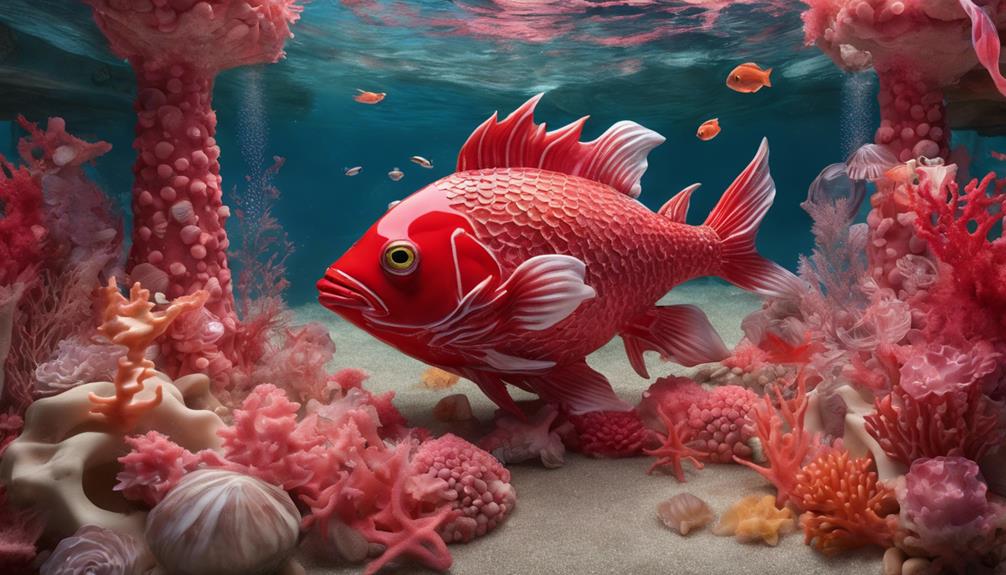
When selecting a name for a girl red fish, consider options that are sweet and simple, nature-inspired, or popular choices among fish enthusiasts.
These names can reflect the vibrant and colorful nature of your red fish, adding a touch of elegance and uniqueness to their identity.
Opt for a name that resonates with the individuality and charm of your fish, ensuring it's easy to remember and suits their personality perfectly.
Sweet and Simple
Sweet and simple names for female red fish like Chelsea, Rosalie, and Spice exude a charming quality that perfectly suits these aquatic companions.
Consider names such as Fiona or Blush for a touch of uniqueness, adding to your pet fish's identity.
Names like Poppy or Terra can bring a sense of individuality to your red fish, while Autumn, Sunset, or Peony may suit those with warm and vibrant personalities.
Valentina, Suri, Foxy, or Sundance reflect the beauty and charm of your red fish, making them perfect choices for your aquatic friend.
Each name carries its own essence, enhancing the bond you share with your beloved pet fish.
Nature-Inspired Names
Nature-inspired names for female red fish can capture the essence of the vibrant hues and beauty found in the natural world. When naming your tropical red fish, consider options like Ruby or Poppy to reflect the intense colors of nature.
Names such as Autumn or Sunset can evoke the warm tones of changing seasons, adding a touch of elegance to your aquarium.
For a delicate and graceful choice, Tulip or Blossom symbolize the beauty of flowers in nature. These nature-inspired names not only connect your red fish to the natural world but also infuse an earthy charm into their identity.
Choose a name that resonates with the organic feel of your aquatic pet, enhancing the beauty of your underwater world.
Popular Choices
Among the popular choices for naming female red fish, names like Donatella, Pandora, and Celeste are highly favored by aquarium enthusiasts. When selecting the perfect name for your aquatic companion, consider these suggestions:
- Sunny: Reflecting the vibrant and warm nature of your red fish.
- Orchid: Adding an elegant and exotic touch to your fish's identity.
- Scarlet: Emphasizing the striking red color of your aquatic friend.
- Aurora: Symbolizing the beauty and grace of your red fish.
These popular names can help create a special bond with your fish, making their identity unique and memorable. Choose a name that resonates with you and captures the essence of your beloved aquatic pet.
Name Suggestions for Boys
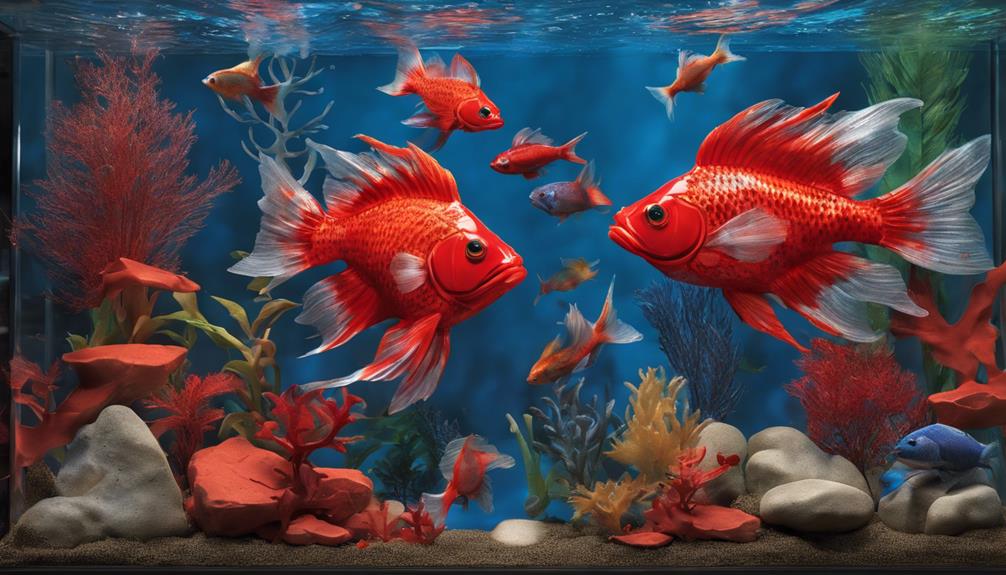
When choosing names for boys, consider drawing inspiration from vibrant colors like Ruby or Crimson. Names like Pike or Coral can be excellent choices for a male red fish, reflecting their bold and striking appearance. Here are some suggestions for naming your red fish:
| Name | Description |
|---|---|
| Ruby | A classic and elegant choice |
| Crimson | Reflects the intense red color |
| Blaze | Perfect for a fiery and active fish |
| Phoenix | Symbolizing rebirth and strength |
| Jasper | Evokes the deep red hues |
| Rusty | Adds a touch of charm and warmth |
Choosing a name that resonates with your pet's personality or characteristics can create a special bond. Unique names like Rosebud or Darth can add a fun twist, while funny names like Grouper or Draco can bring humor to the naming process. Remember, the name you pick should not only sound good but also feel right for your little aquatic friend.
Unisex Name Ideas
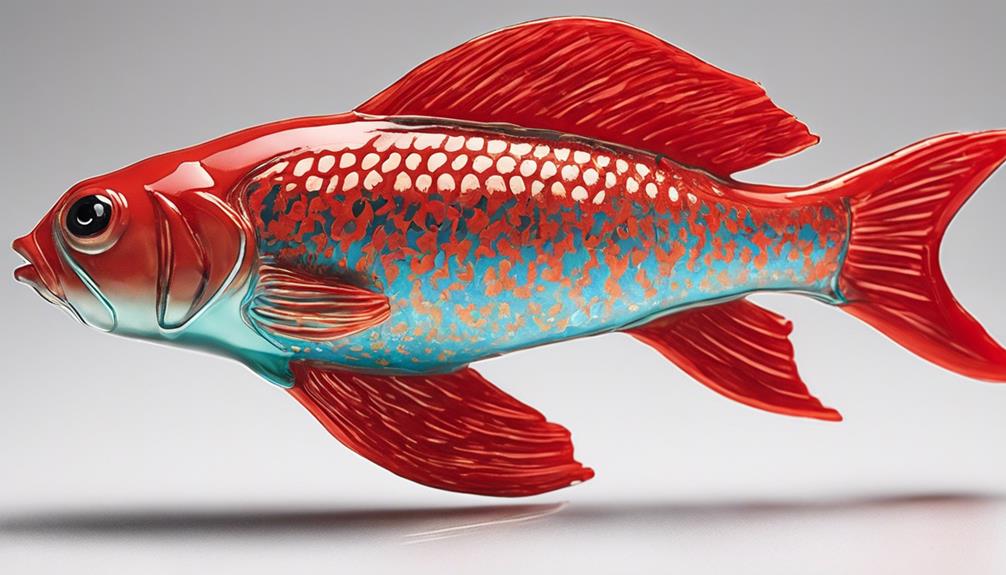
Drawing inspiration from a variety of sources, we can explore versatile unisex name ideas that suit red fish of any gender. When choosing a unisex name for your red fish, consider names that embody inclusivity and creativity.
Here are some unisex name ideas for your red fish:
- Crimson: A vibrant and striking name that reflects the beautiful color of your red fish.
- Blaze: This name signifies energy and intensity, perfect for a lively red fish.
- Ember: A name that evokes warmth and brightness, ideal for a friendly red fish.
- Phoenix: Symbolizing rebirth and renewal, this name adds a mystical touch to your red fish's identity.
These unisex names offer a wide range of options to personalize your red fish's identity while maintaining a gender-neutral approach. Choosing a unisex name can enhance the bond between you and your red fish, adding a fun and distinctive element to your relationship.
Tips for Choosing the Perfect Name

To select the ideal name for your red fish, we should consider its unique personality traits for a more profound connection. When naming your aquatic companion, it's important to think about characteristics that make them special.
Perhaps they've a quirky behavior or a charming way of greeting you. Opt for a name that resonates with these traits to forge a strong bond.
Choosing a name inspired by significant events like a rescue story can add depth to your connection. Make sure the name is easy to remember; this will help in building familiarity and rapport with your red fish.
Reflecting the strength and resilience of your fish in the chosen name can highlight their personality and individuality. Good luck in finding the perfect name that captures the essence of your red fish. Make sure it's a name that both you and your aquatic friend are sure to love.
Frequently Asked Questions
What Is the Nickname for Redfish?
We call Redfish by various names: 'Red Drum,' 'channel bass,' 'reds,' 'bull reds' in Louisiana, or even 'fire truck' for their vibrant color. Each nickname captures a unique aspect of these impressive fish.
How Do I Name My Fish?
We think naming fish involves considering their personality traits and unique characteristics. It's important to choose a name that is easy to remember, reflects strength and resilience, and helps in building a strong bond.
What Is the Name of Red Colour Fish?
We love naming red fish! Consider names like Ruby, Garnet, or Rosebud for a sweet touch. Funny options such as Dexter or Grouper can add playfulness. Unique choices like Admiral or Big Red make your fish stand out.
What Should I Name My Cichlid?
What should we name our cichlid? Let's consider its color, origin, and personality. Maybe something inspired by nature or mythology? The name should be easy to remember and reflect our fish's individuality.
Conclusion
In naming your red fish, consider its color, personal significance, and fire-inspired or character-based names. Choose a name that holds special meaning for you, whether it's a place name or a gender-specific suggestion.
Remember, the perfect name is like a key that opens a door to a world of connection and familiarity with your fish. So take your time, consider your options, and find a name that truly resonates with you and your fish's unique personality.
Happy naming!
As our Editor-in-Chief, James plays a pivotal role in ensuring the quality and integrity of our content. With a keen eye for detail and a passion for storytelling, James oversees the editorial process here at A Place for Animals. With years of experience in content editing, James ensures that every piece of content meets our high standards of accuracy and clarity. Under James’ guidance, you can rest assured that the content you read is informative and impeccably crafted.
Fish
Top 3 Pink Fish Names for Your Aquarium
Illuminate your aquarium with the top 3 pink fish names starting with 'I' that will add a pop of color and personality to your underwater world.
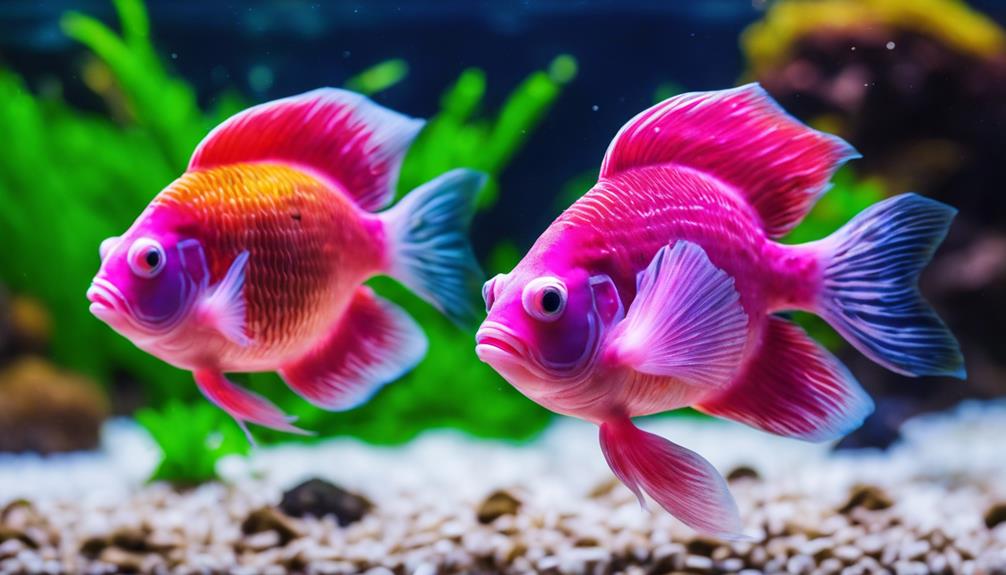
When selecting names for pink fish in your aquarium, consider vibrant options such as Blush, Rose, and Magenta. These colors can bring a lively vibe to your aquatic environment. To add a charming and elegant touch, you may choose names like Ballerina, Tulip, and Rosie. For a more feminine flair, names like Zinnia or Pink Lady can be a great fit. If you prefer a more regal feel, consider names like Duke or Crimson for male fish. For those who enjoy pop culture references, names like Kirby, Pink Panther, or Peppa Pig can spark conversations and give your fish a unique persona. Explore more inspiring names in the world of aquatic life.
Key Takeaways
- Consider names like Blush, Rose, and Magenta for a touch of elegance.
- Opt for unique names inspired by pink hues to make your fish stand out.
- Choose sweet names like Ballerina or Tulip for a delightful vibe.
- Explore pop culture references such as Kirby or Pink Panther.
- Elevate your pink fish's presence with a name that complements its coloration.
Shades of Pink Fish Names
When selecting names for pink fish in your aquarium, consider drawing inspiration from a variety of shades, such as blush, rose, and magenta. These hues offer a rich palette to choose from, allowing you to capture the beauty of pink in your fish's name. Shades like Coral, Blush, and Fuchsia evoke different intensities of pink, reflecting the diverse tones found in nature and art.
By exploring the spectrum of pink shades, you can find the perfect name that complements your fish's coloration. Whether you prefer a soft and delicate name like Rose for a gentle pink fish or a vibrant and bold option like Magenta for a more intense hue, the possibilities are endless. Names inspired by specific shades of pink add a unique touch to your fish's identity, making them stand out in your aquarium.
Embrace the beauty of pink with names that reflect the various shades found in the natural world. Let your fish shine with a name that captures the essence of pink in all its glory.
Sweet and Delightful Inspirations
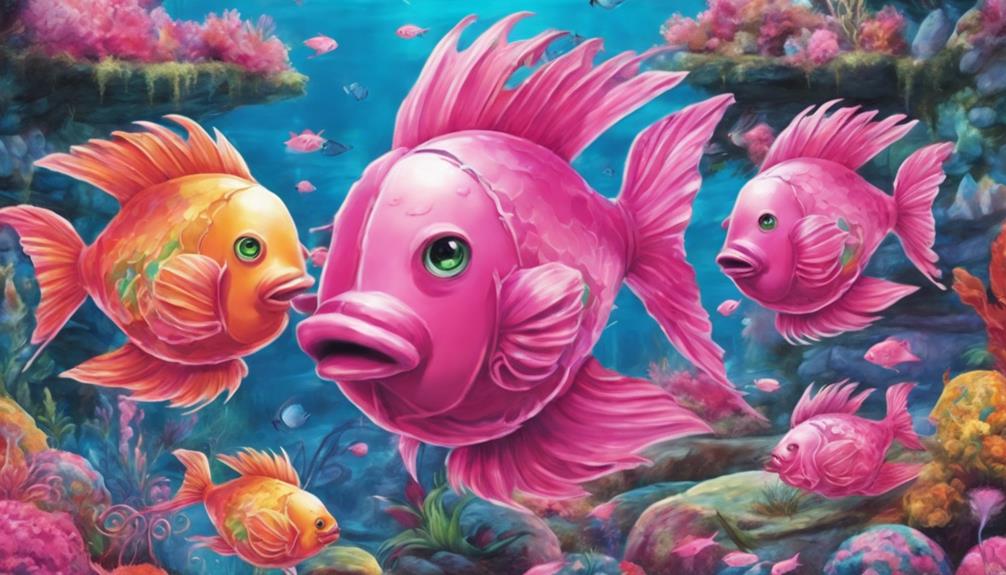
Adding a touch of charm and elegance to your aquarium, sweet and delightful pink fish names can bring a sense of grace and beauty to your aquatic companions. When looking to find the perfect name for your pink fish, consider options that evoke a feeling of cuteness and joy. Names like Ballerina, Tulip, and Rosie aren't only adorable but also reflect the joyful and colorful nature of these aquatic creatures.
For a unique and feminine touch, names such as Zinnia and Pink Lady can be excellent choices. If you have male pink fish, strong and regal names like Duke and Crimson offer a sense of nobility. By selecting a sweet and delightful name, you can create a special bond with your pet fish and enhance the overall ambiance of your aquarium.
Choose wisely, as the right name can truly elevate the presence of your pink fish in their underwater world.
Pop Culture References
Drawing inspiration from popular culture, we can explore exciting and recognizable names for your pink fish. When considering pop culture references for your aquatic companion, characters like Kirby, Pink Panther, and Peppa Pig offer perfect options for naming your pink fish.
These names aren't only cute and memorable but also add a touch of nostalgia to your aquarium. By choosing a name from movies, TV shows, or video games, you can reflect your interests and create a special connection with your fish.
Opting for a pop culture reference can make your pink fish stand out among the others in your aquarium, sparking conversations and admiration from guests. Whether you have a playful Kirby-like fish or a sleek Pink Panther-inspired swimmer, a pop culture name can elevate your pink fish's persona and make them a beloved member of your underwater family.
Frequently Asked Questions
What Is the Pink Fish Called?
We call the pink fish the Rosy Barb. They're lovely freshwater fish with a vibrant pink color. Rosy Barbs are peaceful and enjoy well-planted aquariums. They can grow up to 6 inches and make great community tank inhabitants.
What Is a Cute Name for a Fish?
When picking a cute name for a fish, we aim for something endearing and charming. It's about finding a name that resonates with us and captures the essence of our aquatic friend. Personal connection is key.
What Is the Real Name of the Pink Fish?
The real name of the pink fish commonly found in aquariums is the Rosy Barb. They are vibrant, peaceful, and thrive in schools. These freshwater fish from India, Pakistan, and Bangladesh are social omnivores.
What Should I Name My Cichlid?
When naming our cichlid, let's consider its color, behavior, and unique traits. Researching its species can offer inspiration for a fitting name. Personalizing our aquarium with a name fosters a special bond with our fish.
Conclusion
To sum up, pondering the perfect pink fish names for your aquarium can add a touch of charm and personality to your aquatic environment.
Remember to contemplate the shades of pink, sweet inspirations, and pop culture references to find the ideal name that suits your fish.
By selecting a name that resonates with you, you can create a unique and enjoyable experience for both you and your fish.
So go ahead, get creative, and make your aquarium truly one of a kind.
As our Editor-in-Chief, James plays a pivotal role in ensuring the quality and integrity of our content. With a keen eye for detail and a passion for storytelling, James oversees the editorial process here at A Place for Animals. With years of experience in content editing, James ensures that every piece of content meets our high standards of accuracy and clarity. Under James’ guidance, you can rest assured that the content you read is informative and impeccably crafted.
Fish
Caring for Black Goldfish with Big Eyes: Tips & Facts
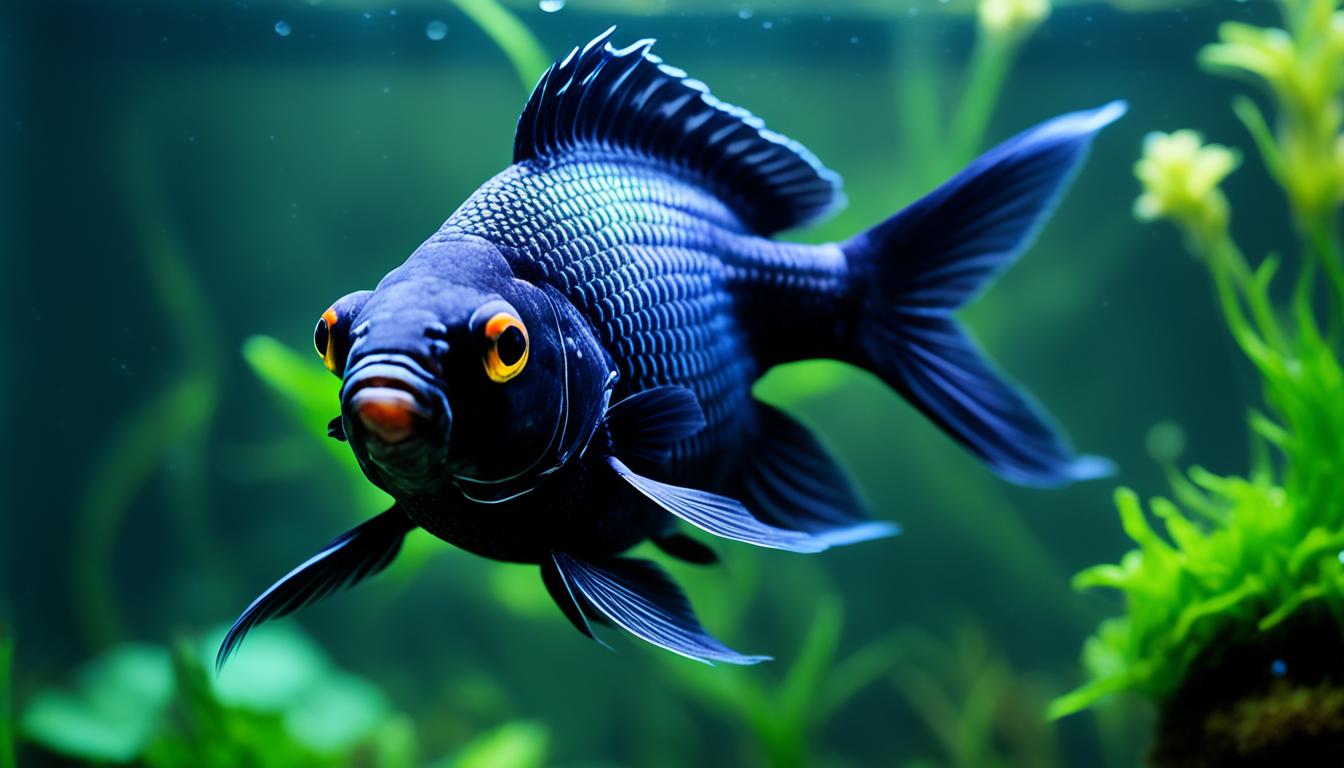
Are you aware that Black Moors, also known as black goldfish with large eyes, have the potential to live up to 20 years as pets? These distinctive fish are a type of goldfish that are recognized by their chubby bodies, elegant flowing fins, and unique bulging eyes. Black Moors make for fascinating pets, needing special attention to guarantee their health and lifespan.
Whether you’re a beginner fishkeeper or an experienced enthusiast, this article will provide you with valuable insights on how to care for Black Moors and create an ideal habitat for them. From tank requirements to feeding habits, we’ll cover all the essentials you need to know to keep these captivating creatures happy and healthy.
Key Takeaways:
- Black Moors, or black goldfish with big eyes, can live up to 20 years as pets.
- They have a round, stubby body, fancy flowing fins, and distinctive protruding eyes.
- Black Moors are not suitable for ponds and are better suited for aquariums.
- A suitable tank size for Black Moors is at least 20 gallons.
- Proper filtration and regular water changes are crucial for maintaining water hygiene.
Black Moor Aquariums
Black Moors, with their unique appearance and big protruding eyes, are a captivating variety of goldfish. These fish, also known as telescope goldfish, require specific care and tank conditions to thrive. While they are not suitable for ponds due to their poor eyesight and slow swimming abilities, they are well-suited for aquariums.
To provide a comfortable habitat for your black moor goldfish, it is recommended to have an aquarium with a minimum size of 20 gallons. This size allows them enough space to swim and explore their surroundings. A larger tank is always better as it provides ample room for growth and enhances their overall well-being.
Black Moors can be kept in either a room temperature tank or a tropical tank with water temperatures up to 25°C (77°F). The temperature range should be consistent, as rapid fluctuations can be harmful to the fish. Ensuring a stable and suitable water temperature promotes a healthy and stress-free environment for your black moors.
As gentle and peaceful fish, black moor goldfish thrive best when housed with compatible tank mates. Consider choosing fish that have a similar temperament and swimming style to avoid harassment and potential fin damage. Some suitable tank mates include other fancy goldfish varieties, small groups of shoaling fish like neon tetras or cherry barbs, and large, slow-swimming fish such as angelfish.
Aquarium Filters for Black Moors
Black Moors are known to be messy eaters, which makes it crucial to have an efficient filtration system in their tank to maintain water hygiene. The right filter will help remove excess food, waste, and other impurities, ensuring a clean and healthy environment for your black moor goldfish.
One popular option for black moor aquariums is the internal canister filter. These filters are easy to use and provide effective mechanical and biological filtration. They are designed to be placed inside the tank, taking up minimal space and allowing for easy maintenance.
In addition to the filter, regular water changes are essential for the well-being of your black moors. Aim for weekly water changes of around 25% to remove accumulated toxins and maintain water quality. This will reduce the risk of diseases and keep your black moor goldfish happy and thriving.
Recommended Aquarium Filters for Black Moors:
| Filter | Key Features | Price |
|---|---|---|
| Tetra Whisper EX Silent Multi-Stage Power Filter |
|
$30.99 |
| Fluval C4 Power Filter |
|
$66.99 |
| Aqueon QuietFlow LED PRO Aquarium Power Filters |
|
$31.99 |
Choose an aquarium filter that suits the size of your black moor tank and meets the filtration needs of the fish. It’s important to consider the tank’s capacity, flow rate, and maintenance requirements when selecting a filter. Regularly monitor the performance of the filter and replace filter media as needed to ensure optimal filtration.
Remember, a properly filtered tank is essential for the health and longevity of your black moor goldfish. By providing clean and well-maintained water, you can create a thriving aquatic environment for your beloved black moors.
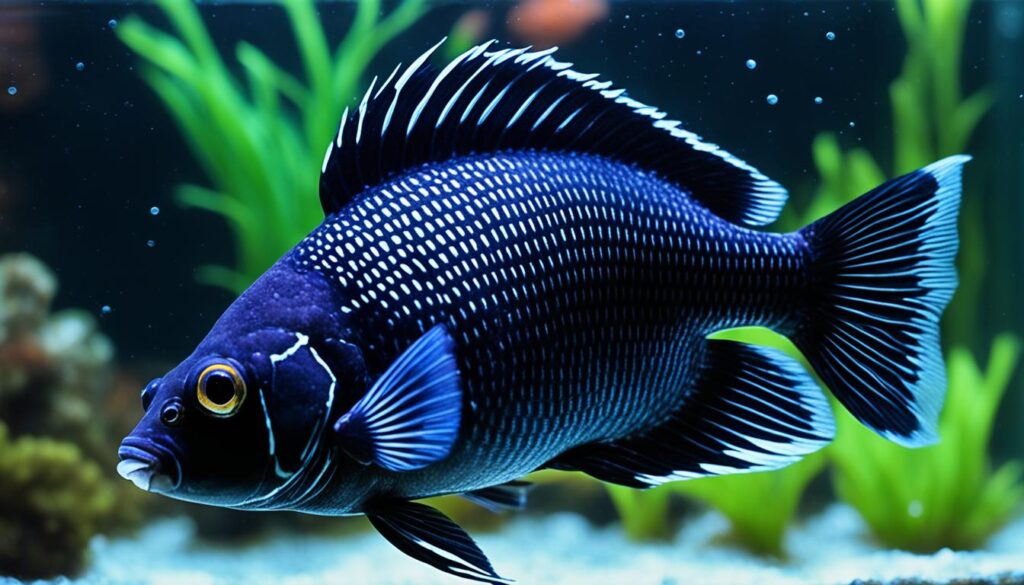
Feeding Black Moors
Black Moors, with their poor eyesight and slow swimming, require special attention when it comes to feeding. It is crucial to ensure they receive sufficient food, especially if they are housed with faster fish. However, overfeeding should be avoided, as it can lead to uneaten food and water pollution. A balanced diet is essential for their overall health and well-being.
When feeding your black moor goldfish, it is recommended to provide small meals once or twice a day, offering only what they can consume within 2-3 minutes. This prevents excessive food from accumulating in the tank. Goldfish flakes serve as a reliable staple food, providing necessary nutrients. However, it’s good to inject variety into their diet by incorporating additional treats such as live foods.
Goldfish flakes are a popular choice for feeding black moors due to their convenience and nutritional value. They are readily available at pet stores and are specifically formulated to meet the dietary needs of goldfish. These flakes typically contain a blend of proteins, vitamins, and minerals essential for their growth and vitality.
Live Foods for Variety
In addition to goldfish flakes, supplying live foods can be beneficial for the health and variety in your black moor’s diet. Live foods mimic the natural feeding behavior of goldfish and can be a delightful treat for your fish. Some commonly offered live foods for black moors include:
- Daphnia
- Brine shrimp
- Bloodworms
- Tubifex worms
These live foods provide additional protein and nutrients, enhancing the diet of your black moor goldfish and promoting optimal growth. However, it’s crucial to source live foods from reputable sources to ensure they are safe and free from parasites or diseases that could harm your fish.
Feeding your black moor goldfish a varied and balanced diet is key to maintaining their health and happiness. Remember to consider their poor eyesight and slow swimming ability when feeding them. With the right approach, you can keep your black moors well-fed and thriving in their aquarium.
Tank Mates for Black Moors
When it comes to selecting tank mates for your black moor goldfish, it’s important to choose peaceful companions that won’t harass or bully them. Here are some compatible fish options that can coexist harmoniously with black moors:
- Fancy goldfish: Fancy goldfish varieties, such as orandas and ranchus, make great tank mates for black moors. They have similar care requirements and swimming speeds, ensuring a peaceful and visually stunning display in your aquarium.
- Small shoaling fish: Adding a small group of shoaling fish, like neon tetras or cherry barbs, creates a lively and dynamic environment in the tank. These small, active fish can bring a splash of color and energy while coexisting peacefully with your black moors.
- Large, slow-swimming fish: Consider incorporating large, slow-swimming fish into the tank, such as angelfish or gouramis. These species complement the black moors’ swimming style and add an interesting contrast in size and movement.
On the other hand, it’s crucial to avoid tank mates that may nip at the black moors’ fins. Aggressive and fin-nipping species like tiger barbs, betta fish, and angelfish should be excluded to ensure the well-being and overall harmony of the aquarium.
By carefully selecting compatible tank mates, you can create a captivating and peaceful aquatic community that showcases the unique beauty of your black moor goldfish.

| Compatible Fish | Remarks |
|---|---|
| Fancy Goldfish (Orandas, Ranchus, etc.) | Similar care requirements and swimming speeds |
| Small Shoaling Fish (Neon Tetras, Cherry Barbs, etc.) | Add color and energy while coexisting peacefully |
| Large, Slow-Swimming Fish (Angelfish, Gouramis, etc.) | Create interesting size and movement contrasts |
Black Moor Goldfish Care and Lifespan
Black Moors, also known as telescope goldfish, are fascinating creatures that require proper care to ensure their well-being. With the right approach, these unique fish can live for 10-15 years in captivity. Here are some essential care tips to help you provide a nurturing environment for your black moors:
Tank Environment
A clean and spacious tank is crucial for the health of black moor goldfish. They should be kept in a freshwater aquarium with consistent water parameters. It is recommended to have a tank with a capacity of at least 20 gallons to provide ample swimming space for these active fish.
When setting up the tank, choose a sand or gravel substrate, which mimics their natural habitat and allows them to forage for food. Adding suitable tank decorations, such as plants and hiding spots, creates a stimulating environment and helps reduce stress for your black moors.
Diet and Feeding
Black moor goldfish are omnivorous, meaning they require a varied diet that includes both plant matter and protein. A balanced diet for black moors should consist of high-quality goldfish flakes or pellets as the main staple. These can be supplemented with fresh or blanched vegetables like peas, lettuce, and spinach.
Additionally, black moors can be given small amounts of live or frozen foods as treats, such as bloodworms, brine shrimp, and daphnia. It is important to avoid overfeeding, as excess food can lead to water pollution and health issues. Feed your black moors only as much as they can consume within 2-3 minutes, once or twice a day.
Water Quality and Disease Prevention
Maintaining good water quality is essential for the health of black moor goldfish. Regular water testing should be conducted to monitor ammonia, nitrite, nitrate, and pH levels. Perform partial water changes of about 25% weekly to remove accumulated waste and ensure a clean environment for your fish.
Disease prevention is also crucial for the well-being of black moors. Keep an eye out for signs of common goldfish diseases, such as ich and fin rot. Quarantining new fish before introducing them to the main tank can help prevent the spread of diseases. It is also advisable to consult a veterinarian experienced in fish care for any specific health concerns.
Care Summary
Proper care is essential for the longevity and well-being of black moor goldfish. Here is a summary of key points to remember when caring for black moors:
- Provide a clean and spacious tank with a suitable substrate and tank decorations.
- Feed a varied diet of high-quality goldfish flakes, supplemented with fresh or blanched vegetables and occasional treats.
- Maintain good water quality through regular testing and partial water changes.
- Monitor for signs of disease and take preventive measures to ensure the health of your black moors.
| Aspect | Care Guidelines |
|---|---|
| Tank Size | At least 20 gallons |
| Substrate | Sand or gravel |
| Tank Decorations | Plants, hiding spots |
| Diet | High-quality goldfish flakes, vegetables, occasional live or frozen foods |
| Water Quality | Regular testing, partial water changes |
| Disease Prevention | Quarantine new fish, consult a veterinarian for specific concerns |
By following these care guidelines and dedicating time and attention to your black moor goldfish, you can provide them with a fulfilling and happy life in your aquarium.
Breeding Black Moors
Breeding black moor goldfish is a straightforward process that even beginners can successfully accomplish. These unique fish typically reach sexual maturity at around one year old, making them ready for the breeding process. To encourage spawning, it is essential to set up dedicated breeding tanks with identical water conditions and appropriate decorations.
Male black moors display courtship behavior by swimming around the females in graceful circles. The females, in turn, lay their eggs on flat surfaces within the tank. After fertilization, it is crucial to remove the parents from the breeding tank to protect the eggs from potential harm. The eggs will hatch in a few days, and the fry can be raised separately.
Successful breeding requires careful attention to detail and creating the ideal conditions for black moors to reproduce. By following the recommended steps and ensuring a suitable environment, hobbyists can enjoy the rewarding experience of witnessing the breeding process and raising a new generation of black moor goldfish.
| Steps for Breeding Black Moors |
|---|
| 1. Set up a dedicated breeding tank with matching water conditions |
| 2. Add proper decorations to promote spawning behavior |
| 3. Introduce male and female black moors to the breeding tank |
| 4. Observe courtship behavior, characterized by circular swimming |
| 5. Females will lay eggs on flat surfaces within the tank |
| 6. Remove the parents from the breeding tank to protect the eggs |
| 7. Eggs will hatch within a few days |
| 8. Separate the fry and provide appropriate care |
Black Moor Goldfish Facts & Overview
Black Moors are a man-made variant of goldfish that originated in China in the 1400s. They are a black-colored variant of the telescope goldfish. Black Moors have a peaceful temperament and are ideal for beginner fishkeepers. They can reach a size of 6-8 inches and live for 10-15 years in captivity. Black Moors are not as widely available as other goldfish varieties and can be purchased online from reputable stores.

| Fact | Overview |
|---|---|
| Origin | China, 1400s |
| Temperament | Peaceful |
| Size | 6-8 inches |
| Lifespan | 10-15 years |
| Availability | Less common, can be purchased online |
Conclusion
Black Moors are remarkable fish that captivate with their unique appearance and striking big eyes. When it comes to caring for black moor goldfish, it’s important to provide them with the right environment and attention to ensure their well-being. A suitable tank size, proper filtration, and a varied diet are key factors in ensuring the health and longevity of these fascinating creatures.
With their specific needs met, black moor goldfish can thrive in aquariums and live long, healthy lives. Their peaceful temperament makes them a great addition to any fishkeeping hobbyist’s collection. Observing these beautiful fish gracefully swim in the comfort of a well-maintained tank can be a rewarding experience for both novice and experienced aquarists.
By providing a clean and spacious tank, installing an appropriate filtration system, and offering a balanced diet, you can create an ideal habitat for black moor goldfish. It is important to remember that each fish is unique, and observing their behavior and adjusting their care accordingly is crucial. With proper care and attention, black moor goldfish can be captivating and rewarding companions for many years to come.FAQ
What are Black Moors?
What size tank do Black Moors need?
What water temperature is suitable for Black Moors?
How often do I need to change the water in the tank?
What should I feed Black Moors?
What fish can I keep with Black Moors in the same tank?
How long do Black Moors live?
How do I breed Black Moors?
Where can I purchase Black Moors?
As our Editor-in-Chief, James plays a pivotal role in ensuring the quality and integrity of our content. With a keen eye for detail and a passion for storytelling, James oversees the editorial process here at A Place for Animals. With years of experience in content editing, James ensures that every piece of content meets our high standards of accuracy and clarity. Under James’ guidance, you can rest assured that the content you read is informative and impeccably crafted.
Fish
Keeping Your Sucker Fish Thriving at Home

Did you know that sucker fish, also known as plecos or plecs, can grow up to 12 inches long and live for 10-15 years in captivity? These intriguing freshwater fish are beloved by aquarium enthusiasts for their distinctive looks and their knack for maintaining clean tank environments. If you’re thinking about adding a sucker fish to your aquarium, it is crucial to educate yourself on how to properly care for them to guarantee that your aquatic buddy flourishes in its new habitat.
Key Takeaways:
- Sucker fish can reach up to 12 inches in length and have a lifespan of 10-15 years in captivity.
- These fish are known for their unique appearance and their ability to keep tank environments clean.
- Proper care is essential to ensure your sucker fish thrives, including providing a suitable tank environment and a well-balanced diet.
- Sucker fish are peaceful and can live with other fish, as long as the tank is not overcrowded.
- Regular tank maintenance is necessary to maintain optimal water quality for all aquarium inhabitants.
Sucker Fish Facts & Overview
Sucker fish, also known as “suctorial” fish, are fascinating freshwater species with unique characteristics and behaviors. Belonging to the family Catostomidae, these fish are primarily herbivorous or detritivorous, playing a crucial role in maintaining the health and balance of freshwater ecosystems. Let’s explore some interesting facts about these incredible bottom-feeders.
The Distinctive Mouth Structures
Sucker fish are easily recognizable by their round, suckermouths, which are specifically adapted for their feeding habits. These mouths act as powerful suction cups, allowing the fish to attach themselves to various surfaces, including rocks, plants, and even aquarium walls. This unique feature enables them to graze on algae and consume detritus, contributing to the overall cleanliness of their environment.
Impressive Bottom-Feeding Abilities
One of the key characteristics of sucker fish is their remarkable ability to consume excess algae, detritus, and small invertebrates from the bottom of freshwater habitats. By removing these unwanted elements, they help maintain water quality and prevent the overgrowth of algae, which can be detrimental to other aquatic life. Their diligent bottom-feeding behavior is essential for promoting a healthy and balanced ecosystem.
Diversity and Distribution
Sucker fish can be found in various freshwater habitats worldwide, including North America, China, and Russia. They come in a wide range of sizes, with some species growing to over two feet in length. These fish exhibit diverse physical characteristics, such as elongated bodies and unique color patterns that provide excellent camouflage in their natural surroundings. The combination of their diverse breeding and reproductive behaviors contributes to their widespread distribution and overall adaptability in different environments.
Now that we’ve discovered some fascinating facts about sucker fish, let’s delve deeper into their appearance and behavior in the next section.

Appearance & Behavior
Sucker fish are fascinating creatures with distinctive physical traits and interesting behaviors. Let’s explore their appearance and behavior in detail.
Distinctive Appearance
Sucker fish are easily recognizable by their unique round, suckermouths and elongated bodies. These fish possess fleshy, large lips that form a powerful suction force, allowing them to attach themselves to various surfaces. This adaptation enables them to graze on algae and cling onto rocks or other objects in their environment. The colors and patterns on their bodies provide excellent camouflage, helping them blend in seamlessly with their surroundings.
Curious to see how a sucker fish looks like? Take a look at the image below:
Peaceful Behavior and Feeding Habits
Sucker fish are known for their non-aggressive nature, making them suitable tank mates for other fish species. As bottom feeders, they spend a significant amount of time near the substrate of the aquarium. Here, they search for food, munching on algae and scavenging leftover food. This behavior helps to keep the tank clean and algae-free.
Due to their nocturnal tendencies, sucker fish prefer dim lighting in the tank. Providing hiding spots, such as caves or driftwood, is essential to mimic their natural habitat and ensure their comfort. Additionally, it’s important to note that sucker fish have been known to jump out of the water, so a secure lid for the tank is necessary to prevent any accidents.
In Summary
Sucker fish have a fascinating appearance, with their round, suckermouths and elongated bodies. They are non-aggressive bottom feeders, spending most of their time near the substrate, grazing on algae and scavenging for food. Their peaceful nature makes them excellent tank mates for other fish species. However, it’s important to provide adequate hiding spots and a secure lid to prevent any mishaps. Now that we understand their appearance and behavior, let’s dive deeper into their care requirements in the upcoming section.
Sucker Fish Care
Sucker fish are relatively easy to care for due to their laid-back personalities and willingness to eat leftovers. They play an important role in maintaining a clean tank environment by consuming algae and leftover food, reducing the need for frequent cleaning. To ensure the well-being of your sucker fish, there are several key care considerations to keep in mind.
Tank Size and Filtration
First, make sure you have a tank that is large enough to accommodate the size of your sucker fish. As they can grow up to 12 inches in length, adequate space is crucial for their comfort and overall health. Additionally, provide a well-functioning filter to handle their waste and maintain optimal water quality. A clean and properly filtered tank is essential for the well-being of your sucker fish.
Water Parameters
Maintaining the right water parameters is vital for the health of your sucker fish. Keep the water temperature between 72 and 78°F to ensure they thrive in their environment. The pH level should be maintained between 6.5 and 7.5. Sucker fish prefer a water hardness between 5 and 19 dH. Regularly test the water parameters and make adjustments as needed to create a suitable habitat for your fish.
Substrate and Feeding
Provide at least 2.5 inches of substrate in the tank to allow your sucker fish to burrow and feed. Sinking pellets or other suitable food should be offered to meet their dietary needs. Don’t forget to supplement their diet with fresh vegetables, such as lettuce, cucumber, zucchini, and sweet potato. These additions provide essential nutrients and variety for their overall health.
Regular Cleaning and Water Changes
Sucker fish help maintain a cleaner tank environment, but regular cleaning and water changes are still necessary. Perform routine tank cleaning to remove any excess waste and debris. Water changes ensure optimal water quality and prevent the buildup of harmful substances. Aim to change a portion of the water every one to two weeks, depending on the size of your tank and the number of fish.
By following these care tips, you can provide your sucker fish with a healthy and thriving environment. Remember to monitor their behavior and make adjustments as needed. With proper care and attention, your sucker fish will reward you with their unique presence and valuable tank-cleaning abilities.

Habitat and Tank Requirements
Creating a suitable habitat for your sucker fish is vital to ensure their well-being and happiness. Mimicking their natural freshwater rivers and lakes is key to providing a comfortable environment for these unique fish.
| Requirement | Details |
|---|---|
| Tank Setup | The tank should have a well-functioning filter that ensures clean and clear water. Sucker fish prefer slow-moving freshwater, so adjust the flow accordingly. |
| Water Parameters | Maintain a water temperature between 72 and 78°F for optimal conditions. The pH level should be kept between 6.5 and 7.5. Sucker fish thrive in water with a moderate hardness, between 5 and 19 dH. |
| Substrate | Provide at least 2.5 inches of suitable substrate, such as aquarium sand. This will allow your sucker fish to burrow and feed comfortably. |
| Plants and Decorations | Add deep-rooted and quick-growing plants to the tank. These plants serve as hiding places and contribute to the overall health of the aquarium ecosystem. Decorations like caves and driftwood also provide additional hiding spots. |
| Lid | It’s essential to have a sturdy lid for the tank to prevent the sucker fish from jumping out. This ensures their safety and eliminates the risk of accidental injuries. |
By recreating the sucker fish’s natural habitat, you can provide them with a comfortable and stimulating environment that promotes their overall well-being.
Tank Mates
When it comes to choosing tank mates for your sucker fish, it’s important to consider their peaceful nature and compatibility with other fish. Sucker fish are generally non-aggressive and can live harmoniously with a variety of tropical freshwater fish. However, a few key factors should be taken into account to ensure a peaceful coexistence in the tank.
Avoid housing your sucker fish with burrowing fish or aggressive species like eels and knife fish. These can pose a threat to the peaceful nature of your sucker fish. Instead, opt for tank mates that dwell in the top and mid-sections of the tank, as this helps prevent territorial issues and ensures everyone has their own space.
Here are some suitable tank mates for your sucker fish:
- Hatchetfish
- Pencilfish
- Certain species of cichlids
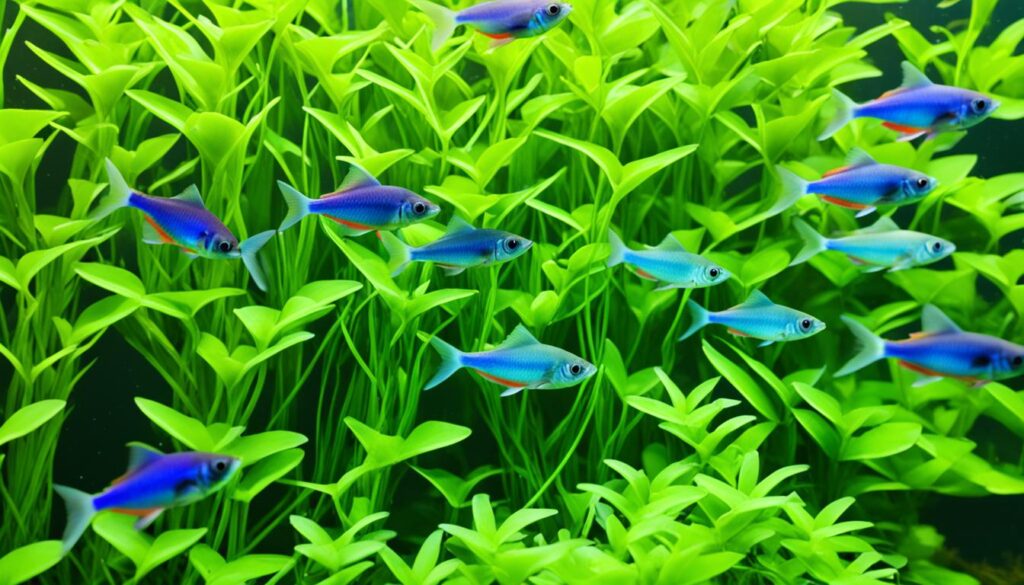
These fish are known for their peaceful nature and can coexist well with sucker fish in an aquarium. Their compatibility leads to a more harmonious tank environment, where everyone can thrive. It’s important to note that compatibility can vary depending on the individual personalities of the fish, so observation is crucial when introducing new tank mates.
On the other hand, it’s best to avoid housing your sucker fish with crabs and snails. Sucker fish may nip at or potentially consume these creatures, leading to an imbalance in your tank ecosystem. By selecting compatible tank mates, you can ensure a peaceful and thriving community within your aquarium.
Diet and Feeding
When it comes to the diet and feeding habits of sucker fish, it’s important to understand their role as algae eaters and their preference for scavenging at the bottom of the tank. Sucker fish are primarily herbivorous, and their diet consists of algae and leftover food in the tank.
To ensure their nutritional needs are met, it’s recommended to provide sinking pellets or algae wafers specifically formulated for sucker fish. These sinking foods mimic their natural feeding behavior, as they scrounge for food at the bottom of the tank.

In addition to prepared foods, it’s beneficial to supplement their diet with fresh vegetables. Sucker fish particularly enjoy lettuce, cucumber, zucchini, and sweet potato. To prevent these fresh foods from floating, you can attach them to a rock using a rubber band.
For optimal feeding, it’s best to feed your sucker fish in the evening and remove any leftovers in the morning to prevent water murkiness and maintain good water quality. It’s important to note that in a well-populated tank, enough food should fall to the bottom to ensure all the sucker fish have access to food.
Key Points:
- Sucker fish are primarily herbivorous, feeding on algae and leftover food.
- Sinking pellets or algae wafers are ideal for their diet, as they scrounge for food at the bottom of the tank.
- Supplement their diet with fresh vegetables like lettuce, cucumber, zucchini, and sweet potato, attached to a rock to prevent floating.
- Feed them in the evening and remove any leftovers in the morning to maintain good water quality.
Breeding
Sucker fish are fascinating creatures that display a range of breeding and reproductive behaviors. Depending on the species, some sucker fish are egg-layers, while others are live-bearers. Egg-laying species typically bury their eggs in the substrate or attach them to plants and rocks, providing a suitable environment for incubation. On the other hand, livebearers give birth to fully developed fry, bypassing the egg stage altogether.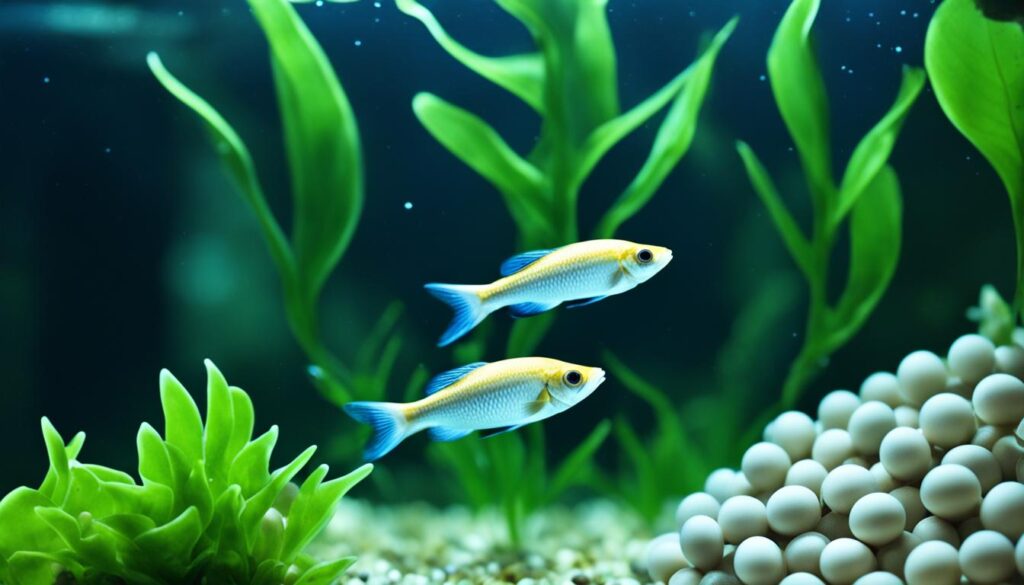
Breeding sucker fish in a home aquarium can be a rewarding but challenging endeavor. These fish have specific requirements and triggers that must be met to initiate the breeding process successfully. Before attempting breeding, it is crucial to research the specific breeding requirements for the species you have.
“Breeding sucker fish requires careful consideration of species-specific requirements and triggers.”
Some factors that influence sucker fish breeding include water parameters, tank setup, and the reproductive behavior of the particular species. These fish thrive in water conditions that replicate their natural habitat, so maintaining optimal water quality is crucial. Additionally, providing suitable hiding places, such as caves or vegetation, can encourage spawning behavior and provide a safe environment for the eggs or fry.
If you are interested in breeding sucker fish, it is recommended to start with a well-established and healthy group of fish. Ensure that both males and females are present and that the tank conditions meet their specific needs. Provide a balanced diet and monitor their behavior closely for any signs of courtship or territorial displays.
Comparison of Egg-Laying and Live-Bearing Sucker Fish
| Egg-Laying Sucker Fish | Live-Bearing Sucker Fish |
|---|---|
| Deposits eggs in the substrate or attaches them to plants and rocks | Give birth to fully developed fry |
| Requires specific conditions for successful egg incubation | No need for incubation period |
| Increased vulnerability during egg incubation | Fry are more independent and have a higher survival rate |
Table: Comparison of Egg-Laying and Live-Bearing Sucker Fish
Both egg-laying and live-bearing sucker fish display fascinating reproductive strategies. While egg-laying species require careful management and monitoring during the incubation period, live-bearing species provide a higher chance of survival for their offspring. Breeding sucker fish in captivity allows us to observe the wonders of their reproductive behaviors and contribute to their preservation in the aquarium hobby.
Should You Get a Sucker Fish for Your Aquarium?
Adding a sucker fish to your aquarium can be a fantastic choice for both pet fish enthusiasts and those looking to keep their tank clean and well-maintained. Sucker fish, also known as plecos or plecs, have unique attributes that make them a popular choice among aquarium enthusiasts. Their interesting appearance, laid-back personalities, and tank-cleaning abilities make them a beneficial addition to most aquariums.
However, before deciding to get a sucker fish as a pet, there are a few factors you should consider. It’s important to provide the right care and create an environment that suits their specific needs to ensure their well-being and overall satisfaction.
Caring for Sucker Fish
Sucker fish require a large tank as they grow bigger. These fish can reach up to 12 inches in length, depending on the species. It’s crucial to provide them with a spacious environment, allowing them to swim freely and thrive.
In addition to tank size, water parameters are essential for the health of your sucker fish. Maintaining optimal water quality is crucial, as poor water conditions can lead to stress, disease, and even death. Regular aquarium maintenance, such as cleaning the tank and conducting water changes, is necessary to ensure a healthy living environment for both the sucker fish and other inhabitants of the tank.
Proper diet is another crucial aspect of sucker fish care. While they help keep the tank clean by consuming algae and leftover food, it’s essential to supplement their diet with appropriate food. Sinking pellets or algae wafers formulated for sucker fish should be provided regularly. Fresh vegetables, such as lettuce, cucumber, zucchini, and sweet potato, can also be added to their diet as a healthy treat.
Here’s a summary of key points to consider before getting a sucker fish for your aquarium:
| Considerations | Details |
|---|---|
| Tank Size | Provide a large tank to accommodate their growth. |
| Water Parameters | Maintain optimal water quality through regular tank maintenance. |
| Diet | Supplement their diet with sinking pellets, algae wafers, and fresh vegetables. |
By taking these considerations into account and providing the appropriate care, a sucker fish can be a delightful and beneficial addition to your aquarium. They not only add a unique element to your tank but also contribute to its cleanliness and overall ecosystem balance.
Conclusion
In summary, sucker fish are fascinating freshwater fish that can make a great addition to your aquarium. With their distinctive mouth structures and ability to keep the tank clean, they offer both aesthetic appeal and functional benefits. By providing them with a suitable tank environment that mimics their natural habitat, offering a well-balanced diet, and caring for their specific needs, you can ensure that your sucker fish thrives and lives a happy, healthy life.
Sucker fish are generally peaceful and can coexist with other fish in the same tank, as long as the tank is not overcrowded. However, it’s important to pay attention to tank size and compatibility when choosing tank mates. Remember to maintain optimal water quality through regular cleaning and water changes, as this is crucial for the overall health and well-being of all the aquarium inhabitants.
In conclusion, keeping a sucker fish in your aquarium can be a rewarding experience. Not only do they provide visual interest with their unique appearance, but they also contribute to the cleanliness and balance of the tank ecosystem. Enjoy the presence of these amazing creatures, and let them bring a touch of nature and tranquility into your home aquarium.FAQ
What are the key factors to consider for keeping a sucker fish thriving at home?
What are some interesting facts and an overview of sucker fish?
How do sucker fish appear and behave?
What are the key care tips for keeping sucker fish in good health?
What are the habitat and tank requirements for sucker fish?
Which fish make suitable tank mates for sucker fish?
What is the diet and feeding habits of sucker fish?
What are the breeding behaviors of sucker fish?
Should I get a sucker fish for my aquarium?
What are the key points to remember about sucker fish care?
Dana is our Lead Content Writer, bringing a wealth of knowledge and expertise to our team. With a background deeply rooted in animal studies and a profound love for all creatures, Dana is dedicated to crafting engaging and informative content that resonates with our audience. With Dana at the helm, you can trust that our content is accurate and engaging, catering to the diverse interests of animal enthusiasts everywhere.
-

 Vetted3 months ago
Vetted3 months ago15 Best Dog Food Brands Recommended by Vets for Healthy and Happy Pups
-

 Vetted2 months ago
Vetted2 months ago14 Best Homemade Dog Food Recipes Your Pup Will Love – Vet Approved & Nutritious
-

 Vetted2 months ago
Vetted2 months ago15 Best Cat Foods for Managing Hyperthyroidism – Vet Approved and Feline Friendly
-

 Vetted2 months ago
Vetted2 months ago15 Best Affordable Dog Foods That Won't Break the Bank
-

 Vetted2 months ago
Vetted2 months ago15 Best Dog Foods for Kidney Disease – Expert Recommendations for Your Pet's Health
-

 Vetted2 months ago
Vetted2 months ago15 Best Affordable Cat Foods That Won't Break the Bank
-

 Deers3 months ago
Deers3 months agoCaring for Baby Deer: Tips for Healthy Fawns
-

 Cats1 month ago
Cats1 month agoCat Weight Chart by Age: Kitten to Senior in Lbs










































